1996 PONTIAC PONTIAC inflation pressure
[x] Cancel search: inflation pressurePage 183 of 370
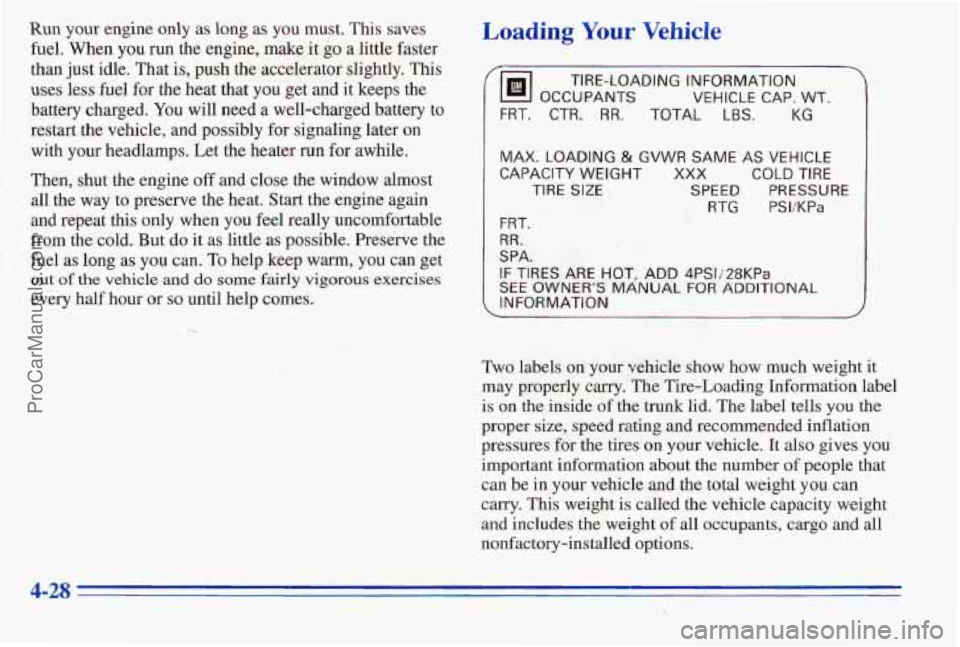
Run your engine only as long as you must. This saves
fuel. When you run the engine,.
make it go a little faster
than just idle. That is, push the accelerator slightly.
This
uses less fuel for the heat that you get and it keeps the
battery charged.
You will need a well-charged battery to
restart the vehicle, and possibly for signaling later on
with your headlamps. Let the heater
run for awhile.
Then, shut the engine
off and close the window almost
all the way to preserve the heat. Start the engine again
and repeat this only when you feel really uncomfortable
from the cold. But do it as little as possible. Preserve the
fuel as long as you can.
To help keep warm,'you can get
out of the vehicle and do some fairly vigorous exercises
every half hour or so until help comes.
.
Loading Your Vehicle
TI!RE-LBADING INFORMATION
VEHICLE
CAP. WT.
FRT, CTR. RR TOTAL LBS.
MAX. LOADING & GVWR SAME AS VEHICLE
CAPACITY
WEIGHT XXX COLD TIRE
TIRE SIZE SPEED PRESSURE
RTG ' PSI/KPa
FRT.
RR.
SPA.
IF TIRES ARE HOT, ADD 4PW28KPa
SEE OWNER'S MANUAL FOR ADDITIONAL
INFORMATION k
Two labels on your vehicle show how much weight it
may properly
carry, The Tire-Loading Information label
is
on the inside of the trunk lid. The label tells you the
proper size, speed rating and recommended inflation
pressures for the tires on your vehicle. It also gives you
important
irmformation about the numb'er of people that
can be
in your vehicle and the total weight you can
carry.
This weight is called' the vehicle capacity weight
and includes the weight
of all occupants, cargo and all
nonfactory-installed options.
ProCarManuals.com
Page 226 of 370
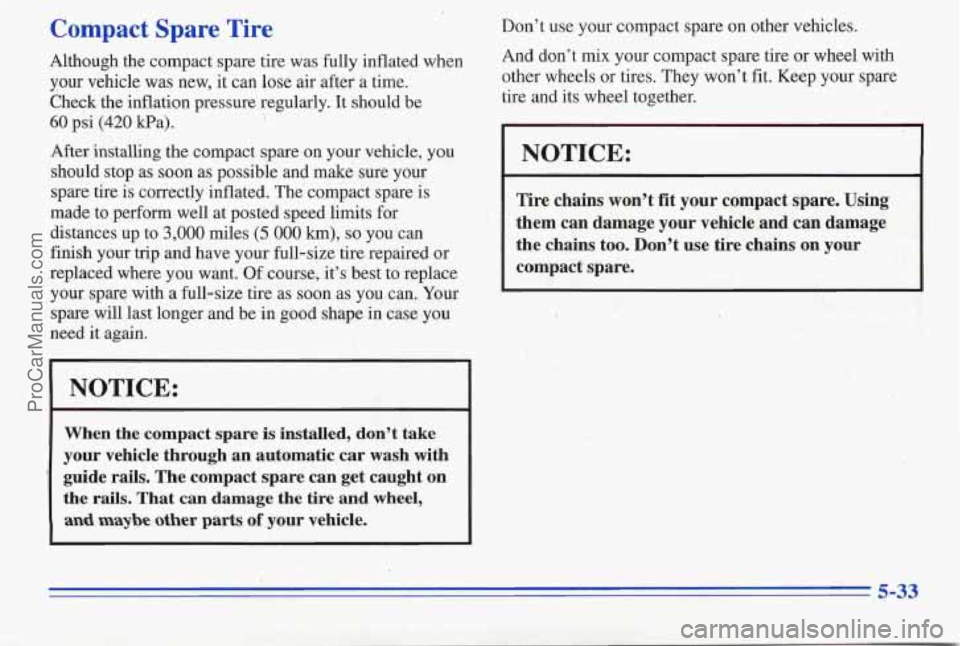
Compact Spare Tire
Although the compact spare tire was fully inflated when
your vehicle was new, it can lose air after a time.
Check, the inflation pressure regularly. It should be
60 psi (420 kPa). ’
After installing the compact spare on your vehicle, you
should stop as soon as possible and make sure your
spare tire
is correctly inflated. The compact spare is
made to perform well at posted speed limits for
distances up to
3,000 miles (5 000 km), so you can
finish your trip and have your full-size
tire repaired or
replaced where you want.
Of course, it’s best to replace
your spare with
a full-size tire as soon as you can. Your
spare will last longer and be in good shape in case you
need
it again.
NOTICE:
When the compact spare is installed, don’t take
your vehicle through an automatic car wash with
’ guide rails. The compact spare can get caught on
the rails. That can damage the
tire and wheel,
and maybe other parts of your vehicle.
Don’t use your compact spare on other vehicles.
And don’t mix your compact spare tire or wheel with
other wheels or tires. They won’t fit. Keep your spare
tire and its wheel together.
NOTICE:
Tire chains won’t fit your compact spare. Using
them can damage your vehicle.and can damage
the chains
too. Don’t use tire chains on your
compact spare.
5-33
ProCarManuals.com
Page 276 of 370
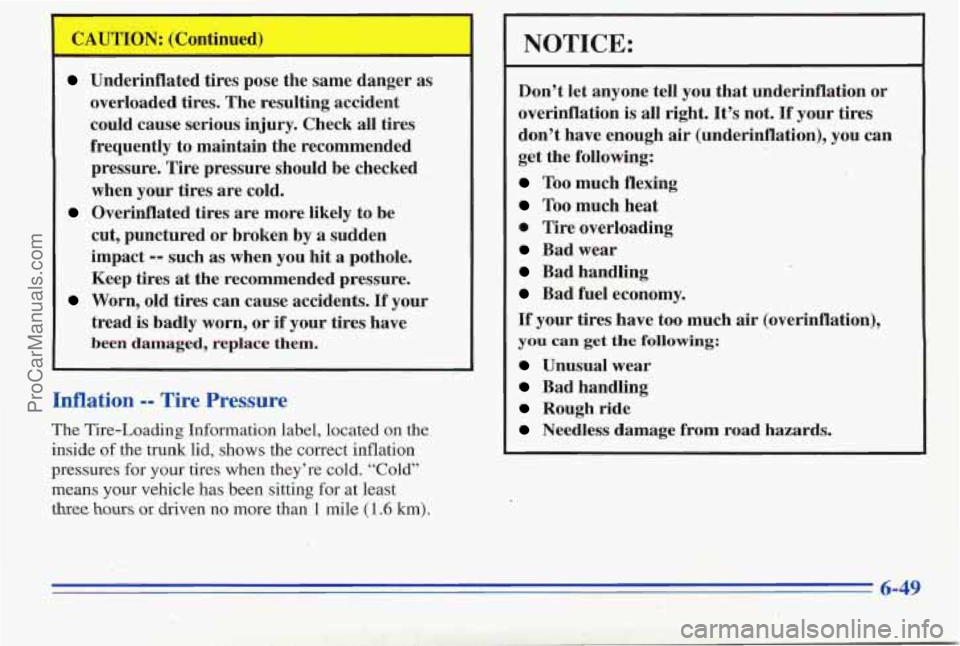
Underinflated tires pose the same danger as
overloaded tires. The resulting accident
could cause serious injury. Check all tires
frequently to maintain the recommended
pressure. Tire pressure should be checked
when your tires are cold.
cut, punctured or broken by
a sudden
impact
-- such as when you hit a pothole.
Keep tires at the recommended pressure.
Worn, old tires can cause accidents. If your
tread is badly worn, or
if your tires have
been damaged, replace them.
Overinflated tires are more likely to be
InflatiIn -- Tire Pressure
The Tire-Loading rnrormation label, located on the
inside of the trunk lid, shows the correct inflation
pressures
for your tires when they’re cold. “Cold”
means your vehicle has been sitting for at least
three hours or driven no more than 1 mile (1.6 km).
NOTICE:
Don’t let anyone tell you that underinflation or
overinflation is all right.
It’s not. If your tires
don’t have enough air (underinflation), you can
get the following:
Too much flexing
Too much heat
0 Tire overloading
Bad wear
Bad handling
Bad fuel economy.
If your tires have too much air (overinflation),
you can get the following:
Unusual wear
Bad handling
Rough ride
Needless damage from road hazards.
6-49
ProCarManuals.com
Page 278 of 370
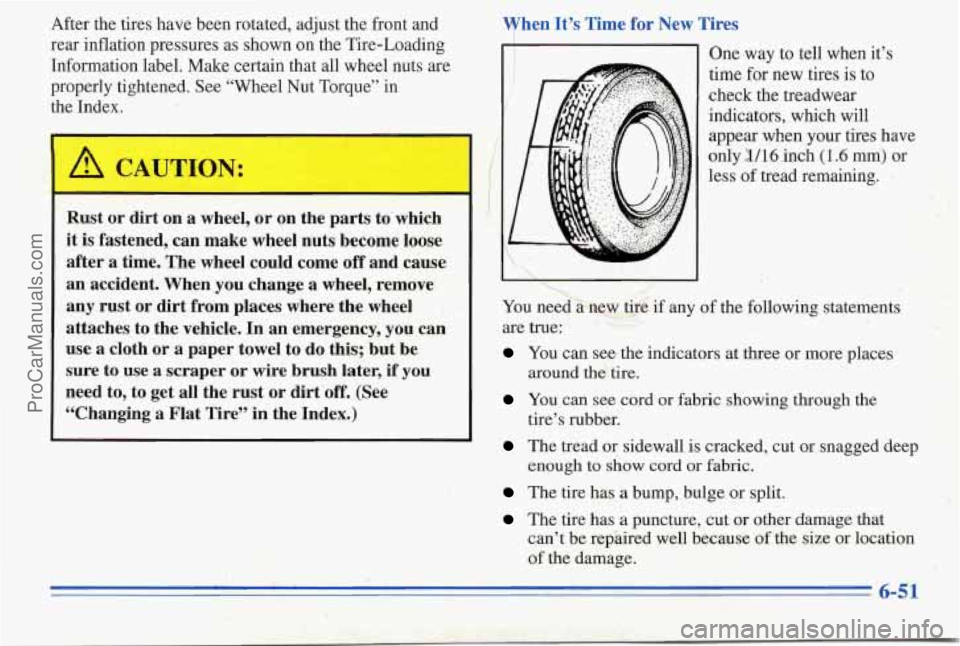
After the tires have been rotated, adjust the front and
rear inflation pressures as shown on the Tire-Loading
Information label. Make certain that all wheel nuts are
properly tightened. See “Wheel Nut Torque” in
the Index.
Rust or dirt on a wheel, or on the parts to-which
it is fastened, can make wheel nuts become loose
after a time. The wheel could come
off and cause
an accident. When you change a wheel, remove
any rust or dirt from places where the wheel
attaches to the vehicle. In an emergency, you can
use a cloth or
a paper towel to do this; but be
sure to use a scraper or wire brush later,
if you
need to, to get all the rust or dirt ‘off. (See
“Changing a Flat Tire” in the Index.)
/ I
I 1 I
Then It’s Time for New Tires
One way to tell when it’s
time for new tires is to
check the treadwear
indicators, which will
appear when your tires have
only
11/16 inch (I .6 mm) or
less of tread remaining.
ll.
You needknwt.re if any of the following statements
are true:
You can see. the indicators at three or more places
You can see cord or fabric showing through the
The tread or sidewall is cracked, cut or snagged deep
~~
around the tire.
tire’s rubber.
6,’ . 1. ‘ 1 enough to show cord or fabric. -. . . ..
;C I ., The tire has a bump, bulge or split.
-1 P. The tire has a puncture, cut or other damage that
can’t be repaired well because
of the size or location
of the damage.
6-51
ProCarManuals.com
Page 339 of 370

Part B: Owner Checks and Services Windshield Washer Fluid Level Check
Listed below are owner checks and services whch Check the windshield washer fluid level in the
should be performed at the intervals specifi’ed to help windshield washer tank and add the proper
fluid if
ensure the safety, dependability and emission control necessary. See “Windshield Washer Fluid” in the Index
performance
of your vehicle. for further details.
Be sure
any necessary repairs are completed at once. At Least Once a Month
Whenever any fluids or lubricants are added to your .- e:. .r- ....
vehicle, make sure they are the proper ones, as shown )z., I ” lire Inflation Check
in Part D. Make sure tires are inflated to the correct pressures.
At Each Fuel Fill See “Tires” in the Index for further details.
It is important for you or a service station attendant to Cassette Deck Service
perjom these underhoad checks at each fuel fill. Clean cassette deck. Cleaning should be done every
Engine Oil Level Check
Check the engine oil level and add the proper oil
if necessary. See “Engine Oil” in the Index for
further details.
50 hours of tape play. See “Audio Systems” in the
Index for further details.
Engine Coolant Level Check
Check the engine coolant level and add the proper
coolant mix if necessary. & ,.. ‘TQgine _i. Coolant” in the
Index for further details. I,
Power Antenna Service
Clean power antenna mast. See “Audio Systems” in the
Index for further details.
ProCarManuals.com
Page 368 of 370
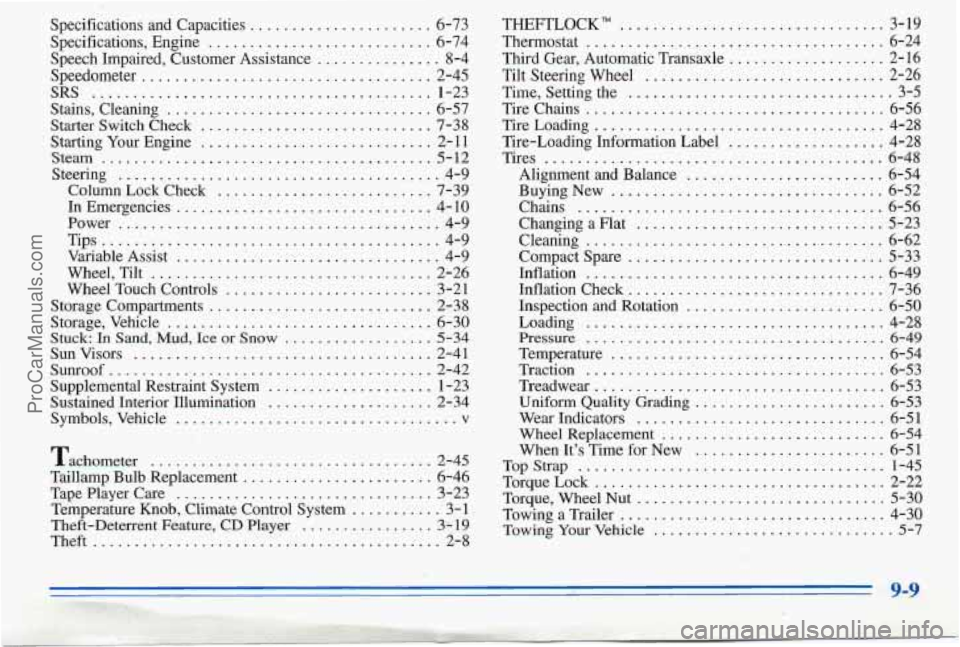
Specifications and Capacities .......... ... 6-73
Specifications. Engine
........................... 6-74
Speech Impaired. Customer Assistance
............... 8-4
Speedometer
................................... 2-45
SRS
......................................... 1-23
Starter Switch Check
.......................... 7-38
Starting Your Engine
............................. 2- 11
Steam
........................................ 5- 12
Steering
....................................... 4-9
Column
Lock Check .......................... 7-39
In Emergencies
............................... 4-10
Power
....................................... 4-9
Tips
......................................... 4-9
Variable Assist
........ ; ....................... 4-9
Wheel, Tilt
................................... 2-26
Wheel Touch Controls
......................... 3 -2 1
Storage Compartments
........................... 2-38
Storage, Vehicle
................................. 6-30
Stuck
In Sand. Mud, Ice or Snow .................. 5-34
SunVisors .................................... 2-41
Supplemental Restraint System
.................... 1-23
Sustained Interior Illumination
.................... 2-34
Symbols. Vehicle
.................................. v
Tachometer .................................. 2-45
Taillamp Bulb Replacement
....................... 6-46
Tapeplayercare
............................... 3-23
Temperature
Knob, Climate Control System ........... 3-1
Theft-Deterrent Feature,
CD Player ................ 3- 19
Theft
.......................................... 2-8
Stains. Cleaning
.......... ........... 6-57
Sunroof ....................................... 2-42
THEFTLOCK
............. ......... 3-19
Thermostat .................................... 6-24
Third Gear. Automatic Transaxle
................... 2-16
Tilt Steering Wheel
............................. 2-26
Time. Setting the
................................ 3-5
Tire Chains .................................... 6-56
Tire Loading
................... ......... 4-28
Tire-Loading Information Label
................... 4-28
Tires
......................................... 6-48
Alignment and Balance ........................ 6-54
Buying New
................................. 6-52
Chains
........... ................... 6-56
Changing
a Flat .............................. 5-23
Cleaning
.................................... 6-62
Compact Spare
............................... 5-33
Inflation
..................................... 6-49
Inflation Check
............................... 7-36
Inspection and Rotation
........................ 6-50
Loading
.... ................................. 4-28
Pressure ..................................... 6-49
Temperature ................................. 6-54
Traction
.................................... 6-53
Treadwear
................................... 6-53
Uniform Quality Grading
....................... 6-53
Wear Indicators
.............................. 6-51
Wheel Replacement
............................ 6-54
When It’s Time for New . . ....... .... 6-51
TopStrap
..................................... 1-45
Torque Lock
................................. ., .. 2-22
Torque, Wheel Nut
.............................. 5-30
TowingaTrailer
................................ 4-30
Towing Your Vehicle
............................. 5-7
c-
ProCarManuals.com